

The International Naval Research Organization is a non-profit organization
dedicated to the encouragement of the study of naval vessels and their
histories, principally in the era of iron and steel warships (about 1860 to date).
Its purpose is to provide information and a means of contact for those
interested in warships. The principal activity of INRO for over 50 years has
been the publication of a quarterly journal, Warship International, recognized
internationally as the leading and most authoritative publication in the field.

© 2021 International Naval Research Organization
January 2025
International Naval Research Organization
Publishers of Warship International
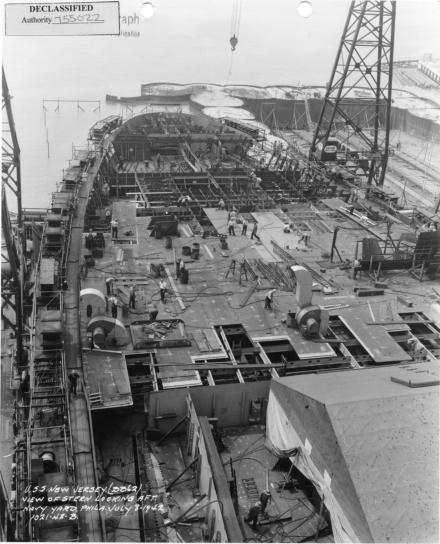
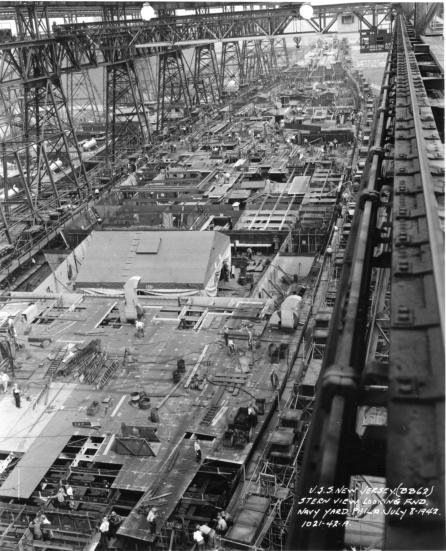
The battleship New Jersey (BB-62) passing through the Panama Canal at the Gaillard Cut on 27 April 1984, en route back to homeport Long
Beach, California, after an extended Mediterranean deployment. Official USN Photograph DN-ST-84-08496, taken by Don S. Montgomery
USN (Ret.) This photograph appeared on the back cover of Warship International Vol.57 No.1. Some new details concerning late changes in
the detail design of this class of ships were published in the journal’s information service feature in Vol.57 No.1 and Vol.57 No.3 in 2020.
New Jersey (BB-62) under construction on the
building ways on 8 July 1942. Official U.S. Navy
Photograph (National Archives), Bureau of Ships
General Correspondence 1940-45. This
photograph appeared with others in the Vol.57
No.1 information service section that covered late
changes in the design for the Iowa class
battleships.
View aft of New Jersey (BB-62) under construction on
the building ways on 8 July 1942. Official U.S. Navy
Photograph (National Archives), Bureau of Ships
General Correspondence 1940-45. This photograph
appeared with others in the Vol.57 No.1 information
service section that described the late changes in the
design for the Iowa class battleships.
The U. S. Navy’s famous battleships of the World War II era have been featured in a number of major articles in
this organization’s journal Warship International over the years. For example, the late Mr. E. R. (Ray) Lewis
authored the article “American Battleship Main Battery Armament—The Final Generation” in Vol.11 (1976) No.4,
detailing for the first time the late discovery of a serious misunderstanding between design bureaus concerning
the diameter of the barbettes intended for the Iowa class. As other examples, our member CDR Strafford Morss
USN (Ret.) authored a series of articles providing extensive detail on the battleship Massachusetts (BB-59) and
others of these ships: “The Machinery Arrangements of USS Massachusetts (BB-59)” in Vol.41 (2004) No.4; “The
Washington Naval Treaty and the Armor and Protective Plating of the USS Massachusetts” in two parts, in Vol.43
(2006) Nos.3-4; and “Excellence Under Stress: A Comparison of Machinery Installations of North Carolina, South
Dakota, Iowa, and Montana Class Battleships” in two parts, Vol.47 No.4 and Vol.48 No.1. Our members Brad D.
Fischer and William J. Jurens provided a detailed study of the actual performance of these ships’ main battery in
the article “Fast Battleship Gunnery During World War II: A Gunnery Revolution” in two parts, Vol.42 (2005) No.2
and Vol.43 (2006) No.1.
While there always has been much popular interest in prominent capital ships such as the World War II-era
battleships, Warship International’s scope of coverage includes the full range of ship types of all nations and treats
a wide range of topics concerning warship design, construction, and operations. The last several years’ content has
included major series of articles on the Imperial Japanese Navy, Imperial German Navy battleship designs, Soviet
Navy Cold War shipbuilding programs, British naval operations on the Russian periphery following World War I, and
many others. The journal seeks to provide new information based upon documented authoritative sources.
Accordingly, our coverage focuses on the years up through World War II, where authoritative official records have
been released to the public and can be used to support such in-depth study.
Information concerning membership in the International Naval Research Organization (INRO), publisher of the
quarterly journal Warship International, may be found on this website at the “membership” tab. Renewal notices
for current members will be included in the No.3 mailing expected during September of each calendar year.
Individual members of INRO will be provided with free online access to all back issues for 1964-2017 on the JSTOR
website. Institutional subscriptions to the journal also are available, see the tab concerning “membership”.
INRO’s website includes a tab for indexes to material appearing in prior issues of the journal, together with
additional information describing the organization. Online indexes are provided both for feature articles and the
many responses to questions posed by members in our Warship Information Service (WIS)/INFOSER feature that
appears in every issue. (Questions are accepted for publication only from current members.)
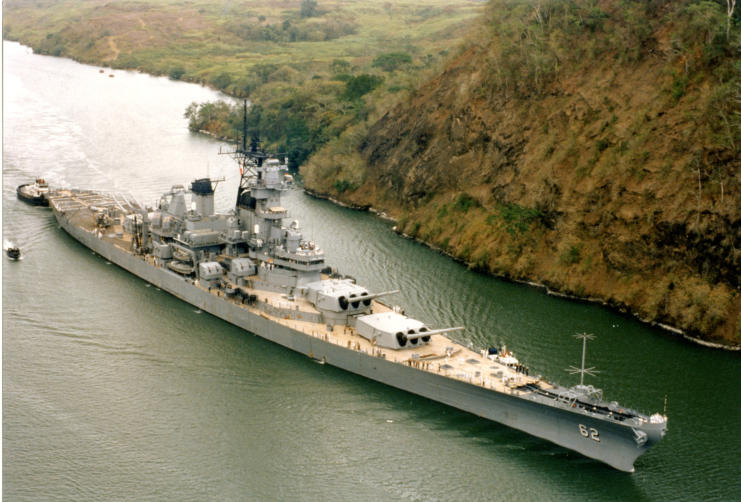
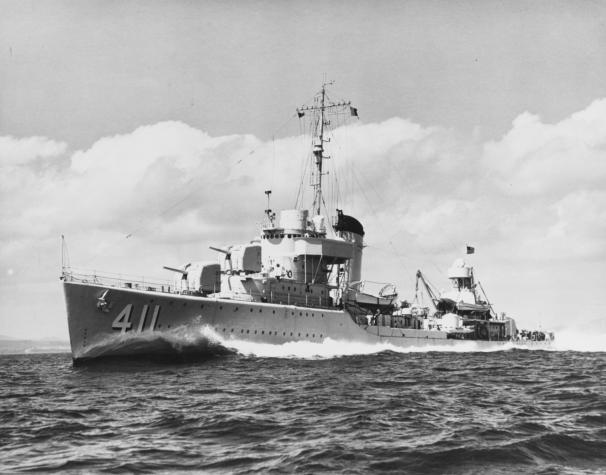
The U. S. Navy Sims (DD-409) class destroyer Anderson (DD-411) underway in the ship’s configuration as completed by the builder, Federal SB &
DD Co., Kearny, New Jersey. Official USN Naval History and Heritage Command Photograph NH 96119. Note that the Mark 37 main battery gun
director has not yet been fitted atop the circular barbette atop the forward deckhouse. The director was installed at New York Navy Yard after
delivery.
The last several classes of U. S. destroyers designed prior to World War II suffered from unexpected displacement
increases upon delivery and in the Sims (DD-409) class as first delivered this added weight created unacceptably poor
stability when in light displacement condition. The story of this unexpected topweight problem and how it was
resolved is recounted in some detail in the journal’s information service feature in Vol.58 (2021) No.2:102-115.
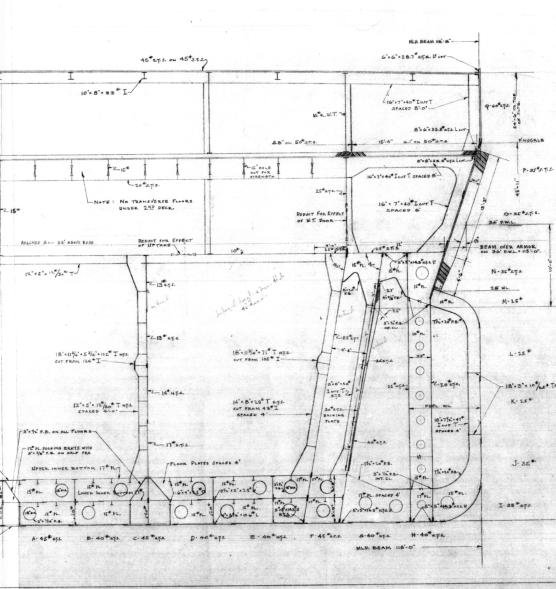
Preliminary Design Branch drawing of the midship section for Montana (BB-67) design 67-4, dated 22 March 1941. NARA Cartographic
Branch, Preliminary Design Drawings. The main side belt has been placed outboard, with a separate lower armor belt (thickest at 7.2-in. at
top, but thinning and joining to 30/40# STS plates below) guarding against underwater trajectory projectiles, set further inboard and inclined
in parallel with the 25# holding bulkhead still further inboard. Deep stiffeners back up the holding bulkhead. Bulkheads No.1 and 2 (20# HTS
and 25# HTS, respectively) are joined by transverse frames 33-in. deep, with lightening holes. Hull shell strakes K and L at about half-draft
level are 25# mild steel. The only discontinuity is the angle between the bottom of the main side belt and its junction with Bulkhead No.1, but
this joint occurred very close to the waterline. Note how all the longitudinal bulkheads are strongly braced with deep frames at top and
bottom.
Questions raised by our members concerning late design changes in the South Dakota (BB-57) class battleships
led to the publication in Vol.57 (2020) No.3:226-250 of a summary of the development of anti-torpedo side
protection systems in the last generation of U. S. battleship designs, based upon research at the U. S. National
Archives. Concerns arising from the test of half-scale Caisson H and 1/16th-scale Caisson No.473 evidently
were the basis for a significant redesign of the machinery space layout of the Iowa (BB-61) class over the
winter of 1939-40. The Montana (BB-67) class battleships represented the final design for such battleship side-
protection systems, shown in the drawing above, and differed significantly from the earlier Iowa (BB-61) class
system, which was very similar to that adopted in the previous South Dakota class. The much larger size and
wider beam of the Montana class enabled provision of a improved system that was rated capable of
preventing defeat of the innermost holding bulkhead from the explosion of a 1000-pound torpedo warhead
detonated at the hull shell at the mid-depth of the ship’s designed load draft.

















